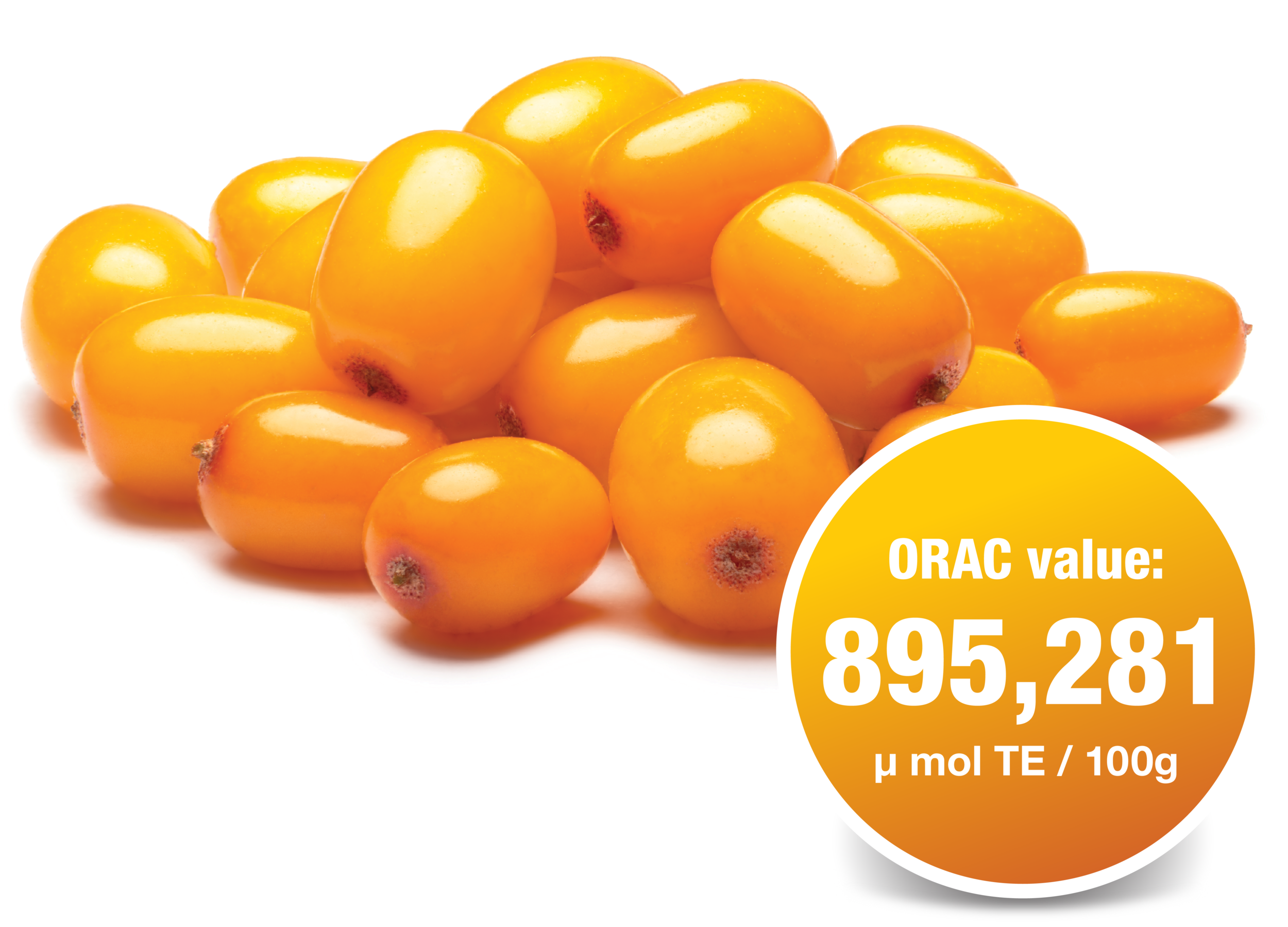Antioxidant
CyanthOx™ is OUR strongest water-soluble antioxidant
According to Oxygen Radical Absorbance Capacity (ORAC) analysis†, CyanthOx™ has an ORAC value of 895,281 μmol TE/100g (Puredia Corporation Limited, 2019).
By comparison, CyanthOx™ is 8 times stronger than grape seed extract (Superfoodly.com, 2019) and 1.7 times more potent than french pine bark extract (Legault et al., 2013).*
†a method of measuring antioxidant capacities in biological samples
ORAC (μmol TE/100g)
CyanthOx™ is a unique sea buckthorn extract with a rich combination of polyphenols, proanthocyanidins, and bioflavonoids, which is one of the strongest plant-based antioxidant.
CyanthOx™ MAY increase SOD, GSH and lowers MDA*
Design: Randomized, placebo-controlled trial was conducted in 106 participants aged from 45 - 65 years old.
Serving Size: Oral intake of 4 x 0.65g of sea buckthorn capsules (6.5% sea buckthorn proanthocyanidins and 16% Omega 3 (ALA)) or placebo per day for 90 days.
Result:
Significant increase in SOD (Superoxide Dismutase) by 11% and GSH (Glutathione) by 4%
Significant reduction in MDA (Malondialdehyde) by 15%
SOD
GSH
MDA
Conclusion: 169mg sea buckthorn proanthocyanidins per day may increase SOD, GSH and lowers MDA.*
(Zou et al., 2010)
CyanthOx™ is 2.7 times stronger than grape seed extract*
Design: Randomized, placebo-controlled trial was conducted in 120 participants aged from 45 - 65 years old.
Dosage: Oral intake of 2 x 0.5g of grape seed extract capsule (10% proanthocyanidins) or placebo per day for 90 days.
Result:
Increase in SOD by 2.3% and GSH by 2.4%
Decrease in MDA by 4.8%
Comparison between sea buckthorn and grape seed proanthocyanidins
Conclusion: Sea buckthorn proanthocyanidins is 2.7 times more effective in increasing SOD and 1.8 times more effective in reducing MDA than grape seed proanthocyanidins.*
(Gao et al., 2010)
CyanthOx™ inhibits oxidation better than grape seed extract*
Design: The antioxidant activities of 92% sea buckthorn proanthocyanidins (SBOPC) and 95% grape seed proanthocyanidins (GSOPC) were analyzed by four assays:
Superoxide anion radical (O₂⁻) assay
Hydroxyl radical (HO) assay
Inhibition of lipid peroxidation assay
2,2-diphenyl-1-picrylhydrazyl (DPPH) assay
Result:
O₂⁻ assay:
EC₅₀ for SBOPC is 23.95μg/mL
EC₅₀ for GSOPC is 107.63μg/mL
HO assay:
The rate constant of reaction for SBOPC is 1.355×10⁹L/g.s
The rate constant of reaction for GSOPC is 1.687×10⁸L/g.s
Inhibition of lipid peroxidation assay:
Conclusion: Sea buckthorn proanthocyanidins is 4.5 times more effective at quenching superoxide anion radical (O₂⁻) and 8 times more effective at quenching hydroxyl radical (HO), and inhibition of lipid peroxidation than grape seed proanthocyanidins.*
(Fan et al., 2007)
Reference
Puredia Corporation Limited. (2019). CyanthOx™80 ORAC Analytical Report. Available at: Here.
Superfoodly.com. (2019). Antioxidant ORAC Value: Grape Seed Extract. [online] Available at: https://www.superfoodly.com/orac-value/grape-seed-extract/.
Legault, J., Girard-Lalancette, K., Dufour, D. and Pichette, A. (2013). Antioxidant Potential of Bark Extracts from Boreal Forest Conifers. Antioxidants, [online] 2(3), pp.77-89. Available at: https://www.ncbi.nlm.nih.gov/pmc/articles/PMC4665433/.
Zou, Y., Xu, R., Liu, L. and Yang, X. (2010). "Seabuckthorn anthocyanin soft capsule" antioxidant testing for human. The Global Seabuckthorn Research and Development, [online] 8(3), pp.7-10. Available at: http://xueshu.baidu.com/usercenter/paper/show?paperid=474b979300b984490a3869e90e8aa8d7&site=xueshu_se&hitarticle=1.
Gao, F., Zhang, K., Song, X., Wu, X. and Zhang, J. (2010). Study on Anti-Oxidation Function of Extraction from Grape Seed to Human. Chinese Journal of Public Health Engineering, [online] 9(2), pp.99-100. Available at: http://a.xueshu.baidu.com/paper/show?paperid=55cf4500e291e1d5ec78aed2bac87a2e.
Fan, J., Luo, L., Wu, T. and Tao, G. (2007). Comparison of antioxidant activity of proanthocyanidins from seed of sea buckthorn and grape. FOOD & MACHINERY, [online] 23(2), pp.26-30. Available at: http://xueshu.baidu.com/usercenter/paper/show?paperid=57ffc99dae773794caeb19cc7974855a&site=xueshu_se&hitarticle=1.








